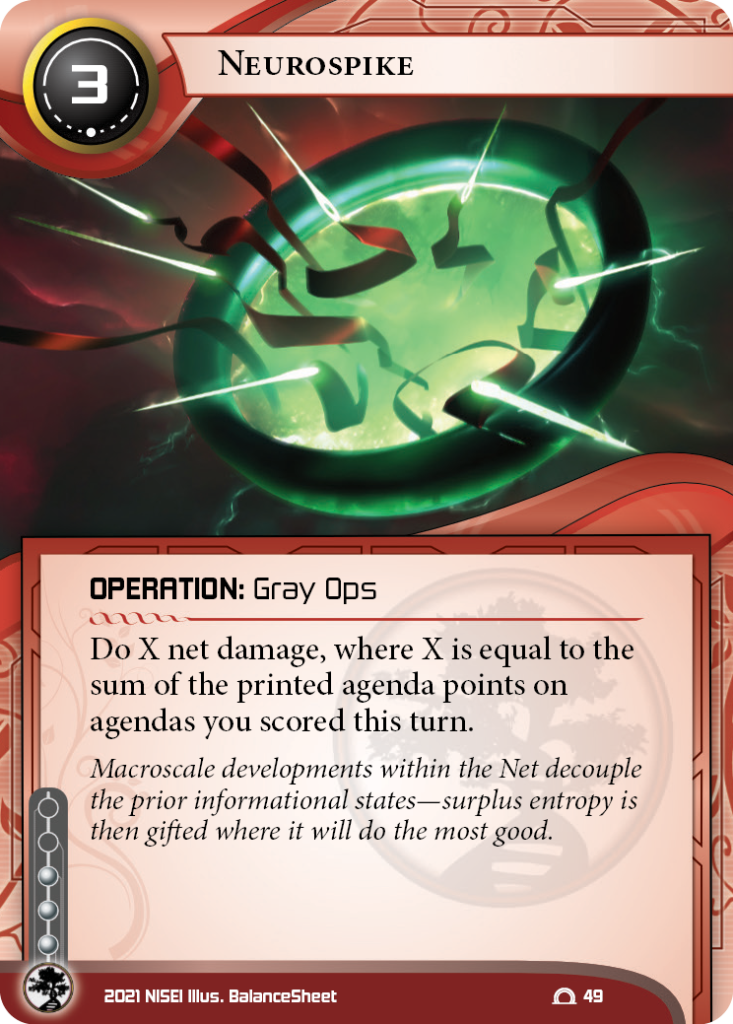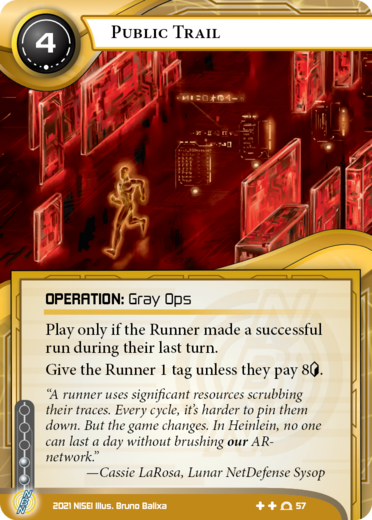Hello Netrunners! As some of you may know, I’m June, Netrunner’s current lead designer. I helped out in the final stages of System Gateway’s design process. Much of what you’ll find in System Gateway was in the NISEI pipeline well before I joined, but today I’ll be talking about a game design change made starting with System Gateway.
But I know you’re eager for scoops, so I want to start this discussion with two very relevant cards from System Gateway. World, please meet Neurospike and Public Trail!
Early versions of Neurospike required a trace to resolve its effect, and Public Trail was originally going to be a SEA Source reprint. You’ll notice that neither card has a trace in its final version—in fact, there’s not a single card with the trace mechanic in all of System Gateway. So how did we end up here?
Trace is a mechanic we’ve had with us since Netrunner’s earliest days. It adds a core economic component to a variety of Runner-Corp interactions, and thematically shows how the Corp might track down a Runner. However, trace is extremely complex. It is a mechanic that relies upon math and cardpool knowledge, and it has a multi-step resolution process. When you add trace to the pile of things someone has to learn in their first—or even third—Netrunner game, learning can get overwhelming quickly.
In my opinion, the trace mechanic itself rarely adds nuance to a game of Netrunner. Typically, a trace boils down to a simple question, “Can the Runner pay or not?”, with a binary outcome: the trace effect either resolves or doesn’t. Most trace cards worth including in decks have a powerful enough effect on resolution that in the vast majority of cases, the Runner will simply pay if they can or become severely punished if they can’t.
On the flip side, cards with less powerful trace effects would be almost identical if you simply removed the trace requirement and instead added a flat credit tax the Runner must pay. The Corp is rarely, if ever, willing to boost these weaker traces, so the multi-step bidding process of the trace tends to amount to unnecessary and complicated baggage.
By way of example, Public Trail fills the role that SEA Source occupied, but in a way that’s simpler to grok. It leads players to the same play pattern but without the extra mechanical baggage of trace.
In the majority of cases, cards with trace can be resolved just as easily without trace. Of course, there are notable exceptions, such as Midseason Replacements, a card that scales by the amount you defeat the Runner in a trace. Long-time Netrunner players may also recall the “zodiac” ice, like Taurus or Sagittarius, whose trace subroutines had extra effects if your trace strength was 5 or more. But in general, a simple “Pay or suffer the consequences” covers the great majority of gameplay interactions involving trace, with much less mechanical overhead.
One of my main objectives as a game designer is managing a game’s depth-to-complexity ratio. Learning a very complex game like Netrunner is rewarding not because it’s difficult to learn, but because it has a depth and richness that makes your time learning it feel well spent. That is, Netrunner earns its right to be as complex as it is through deep, rewarding gameplay.
Unfortunately for trace, it’s on the wrong side of this ratio. Trace is the single most complex mechanic in the game and adds the least gameplay depth in its most common use cases. Navigating its complexity during a game rarely feels worth it. This is why you won’t be seeing trace in System Gateway, a beginner-friendly Netrunner product, and why you might be seeing less of the trace mechanic going forward. This isn’t to say trace won’t make a return once again, but it is being demoted from an “evergreen” mechanic—a mechanic that appears in every release—to a mechanic we’ll explicitly choose to include in a set if we do use it.
Neurospike and Public Trail are fantastic Corporation win conditions, and I’ve been enjoying them in playtesting quite a bit. Look forward to flatlining and tagging Runners in style with them! I’ll be back in the future to write more game design articles—especially as the first cycle I spearheaded as Lead Designer, codenamed “Bashes”, gets closer.
System Gateway and System Update 2021 will be released on or shortly after March 28, 2021, as physical cards via NISEI’s print-on-demand partners and pay-what-you want files for downloading and printing at home!


